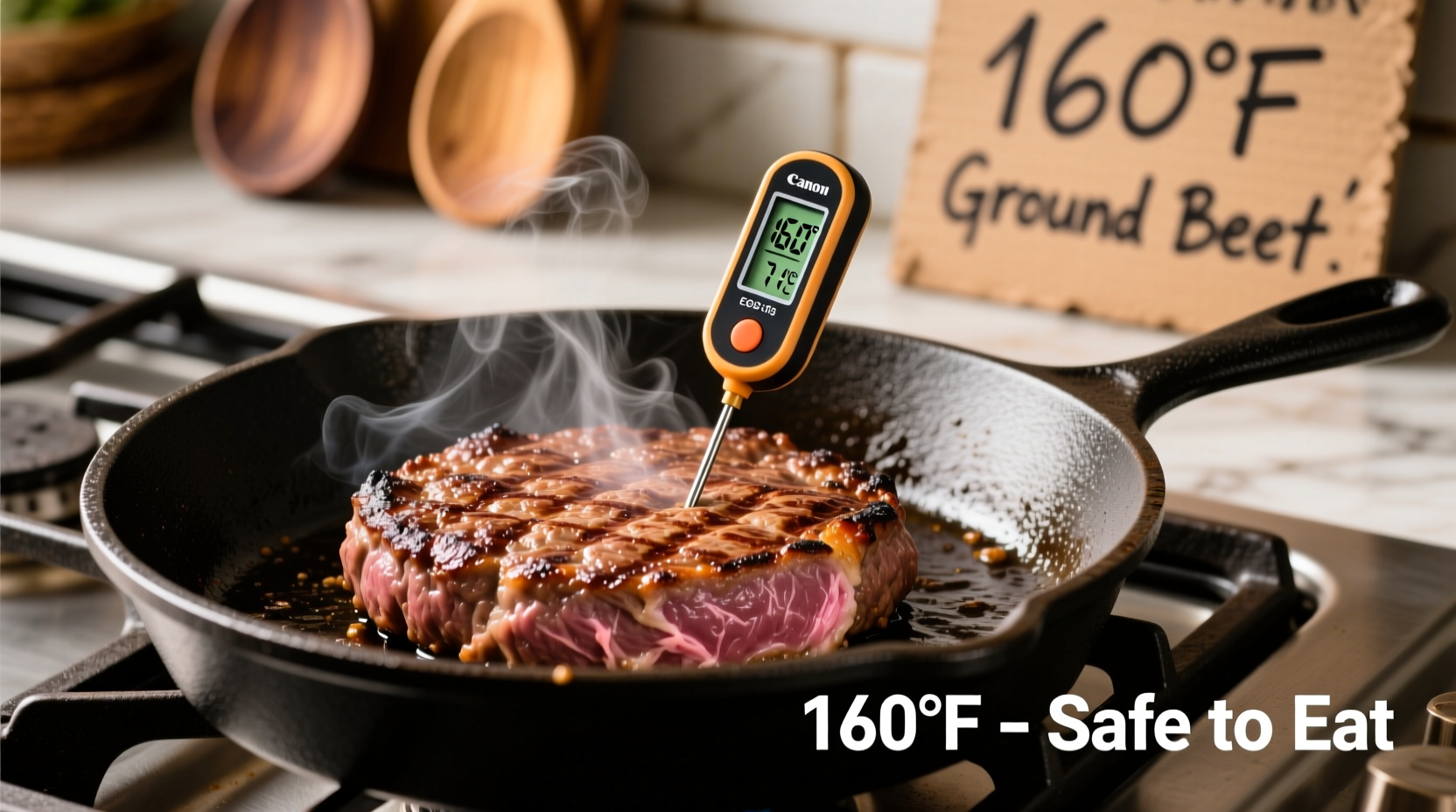Nothing ruins a perfectly grilled burger faster than foodborne illness. When you're handling ground beef, temperature isn't just about preference—it's your primary defense against dangerous pathogens. Unlike whole cuts of meat where bacteria stay on the surface, the grinding process distributes potential contaminants throughout the product. That's why precise temperature control matters more with ground beef than almost any other protein.
Why 160°F Is Non-Negotiable for Ground Beef Safety
The USDA's Food Safety and Inspection Service (FSIS) established 160°F as the minimum safe temperature for ground beef after extensive research on pathogen destruction. At this critical threshold, harmful bacteria including Escherichia coli O157:H7, Salmonella, and Listeria are eliminated within seconds. These pathogens can cause severe illness, particularly dangerous for children, elderly individuals, and those with compromised immune systems.
"Ground beef presents unique food safety challenges because the grinding process transfers surface bacteria into the interior of the meat," explains Dr. Mindy Brashears, former USDA Under Secretary for Food Safety. "Cooking to 160°F ensures these pathogens are destroyed throughout the product."
| Meat Type | Minimum Safe Temperature | Key Pathogens Targeted |
|---|---|---|
| Ground Beef, Pork, Veal, Lamb | 160°F (71°C) | E. coli, Salmonella |
| Ground Turkey, Chicken | 165°F (74°C) | Salmonella, Campylobacter |
| Beef, Pork, Veal, Lamb Steaks/Roasts | 145°F (63°C) + 3min rest | Surface bacteria only |
| Poultry (whole or parts) | 165°F (74°C) | Salmonella, Campylobacter |
This fact comparison table from the USDA Food Safety and Inspection Service demonstrates why ground meats require higher temperatures than whole cuts—the grinding process fundamentally changes the food safety equation.
How to Accurately Measure Ground Beef Temperature
Color alone won't tell you if ground beef is safe to eat. A burger that appears brown throughout might still be under 160°F, while some safely cooked patties retain a pinkish hue due to factors like pH levels or added ingredients. Here's how to check properly:
- Use an instant-read thermometer: Insert the probe into the thickest part of the patty, avoiding contact with the cooking surface
- Check multiple spots: Ground beef cooks unevenly—test several areas of each patty
- Calibrate regularly: Test your thermometer in ice water (should read 32°F/0°C) or boiling water (212°F/100°C at sea level)
- Don't guess: Visual cues like juice color or firmness are unreliable indicators of safety
Common Ground Beef Temperature Mistakes Home Cooks Make
Even experienced cooks fall into these temperature traps that compromise food safety:
- The "Five-Second Rule" for Thermometers: Not waiting for the thermometer reading to stabilize (most digital models need 10-15 seconds)
- Surface-Only Checking: Inserting the thermometer just at the surface rather than deep into the center
- Resting Time Errors: Removing burgers from heat too early, expecting carryover cooking to reach 160°F (ground beef has minimal carryover cooking compared to roasts)
- Thermometer Placement: Positioning the probe near bone or fat, which conducts heat differently than muscle tissue
Cooking Method Considerations for Perfectly Safe Ground Beef
While the target temperature remains constant, different cooking methods require specific approaches to ensure safety:
Grilling: Create an indirect heat zone on your grill. Sear patties over direct heat, then move to indirect heat to finish cooking while monitoring temperature. This prevents exterior charring before interior reaches 160°F.
Stovetop: Use medium heat rather than high. High heat creates a false sense of doneness by browning the exterior while the interior remains undercooked. Stir ground beef frequently when making crumbles to ensure even heating.
Slow Cooking: When using ground beef in slow cooker recipes, always pre-cook to 160°F first. The low temperatures of slow cookers may not reach pathogen-killing levels quickly enough when starting with raw ground meat.
What If My Ground Beef Reaches 160°F But Seems Dry?
Many home cooks worry that cooking to 160°F will produce dry, flavorless burgers. With proper technique, this isn't inevitable:
- Don't overwork the meat: Excessive handling compacts proteins, squeezing out moisture during cooking
- Add moisture enhancers: Mix in 1-2 tablespoons of ice-cold broth or grated onion per pound before forming patties
- Avoid pressing patties: Smashing burgers on the grill forces out precious juices
- Consider fat content: 80/20 lean-to-fat ratio provides optimal moisture while still cooking safely to 160°F
Remember: Safety trumps texture. It's better to have a slightly drier burger than risk food poisoning. The FDA Food Code explicitly states that "time and temperature controls for safety (TCS) foods" like ground beef must reach their minimum internal temperatures to prevent illness.
Special Situations and Exceptions
Certain circumstances require extra temperature vigilance:
- Leftover ground beef: Reheat to 165°F (74°C), not just "hot"
- Cheese-stuffed burgers: The cheese center creates uneven heating—check temperature in multiple spots
- Smaller portions: Meatballs and sliders reach 160°F faster but are harder to temperature-check accurately
- High-altitude cooking: Water boils at lower temperatures, but meat safety temperatures remain unchanged
When preparing ground beef for vulnerable populations (children under 5, adults over 65, pregnant women, immunocompromised individuals), consider using a slightly higher target temperature of 165°F for additional safety margin, as recommended by the Centers for Disease Control and Prevention.
Essential Tools for Perfect Ground Beef Temperature Control
Investing in the right equipment makes safe cooking effortless:
- Digital instant-read thermometer: Thermapen ONE or similar (reads in 2-3 seconds)
- Leave-in probe thermometer: For monitoring multiple patties simultaneously
- Calibration kit: Ice and boiling water verification tools
- Thermometer pocket: Keeps your essential tool within immediate reach
Regular calibration against known temperature points (32°F ice water, 212°F boiling water at your elevation) ensures your readings remain accurate—a critical step many home cooks overlook that can put safety at risk.











 浙公网安备
33010002000092号
浙公网安备
33010002000092号 浙B2-20120091-4
浙B2-20120091-4